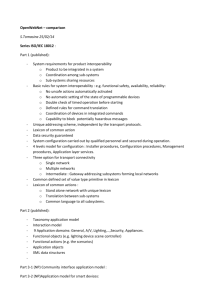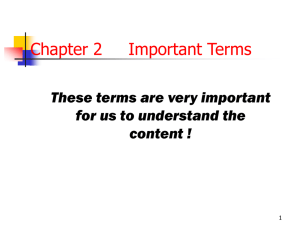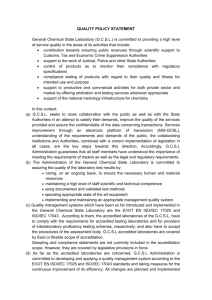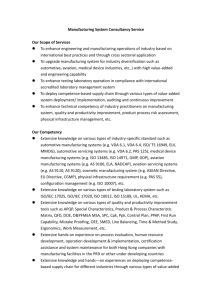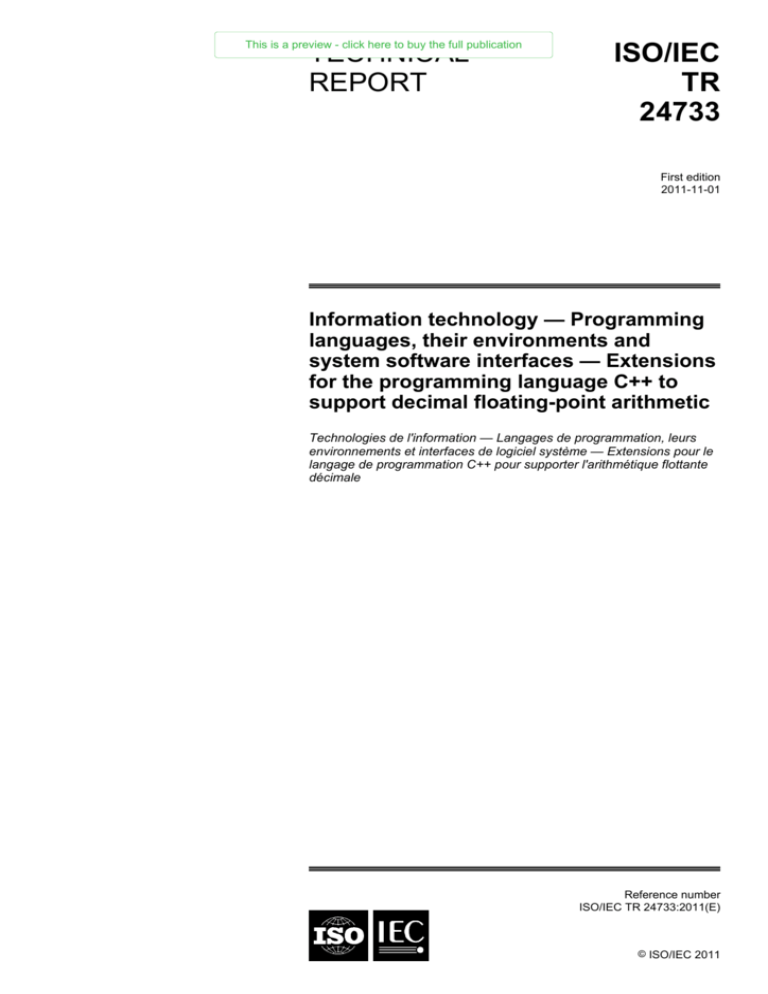
TECHNICAL
REPORT
This is a preview - click here to buy the full publication
ISO/IEC
TR
24733
First edition
2011-11-01
Information technology — Programming
languages, their environments and
system software interfaces — Extensions
for the programming language C++ to
support decimal floating-point arithmetic
Technologies de l'information — Langages de programmation, leurs
environnements et interfaces de logiciel système — Extensions pour le
langage de programmation C++ pour supporter l'arithmétique flottante
décimale
Reference number
ISO/IEC TR 24733:2011(E)
© ISO/IEC 2011
ISO/IEC TR 24733:2011(E)
This is a preview - click here to buy the full publication
COPYRIGHT PROTECTED DOCUMENT
© ISO/IEC 2011
All rights reserved. Unless otherwise specified, no part of this publication may be reproduced or utilized in any form or by any means,
electronic or mechanical, including photocopying and microfilm, without permission in writing from either ISO at the address below or
ISO's member body in the country of the requester.
ISO copyright office
Case postale 56 CH-1211 Geneva 20
Tel. + 41 22 749 01 11
Fax + 41 22 749 09 47
E-mail copyright@iso.org
Web www.iso.org
Published in Switzerland
ii
© ISO/IEC 2011 – All rights reserved
ISO/IEC TR 24733:2011(E)
Contents
Page
Foreword .......................................................................................................................... vi Introduction ......................................................................................................................vii 0.1 General .................................................................................................................... vii 0.2 Arithmetic model .................................................................................................... vii 0.3 The Formats ........................................................................................................... viii 1 Scope ............................................................................................................................. 1 2 Normative references ..................................................................................................... 1 3 Conventions ................................................................................................................... 2 3.1 General ...................................................................................................................... 2 3.2 Relation to C++ Standard Library Introduction ........................................................ 2 3.3 Relation to "Technical Report on C++ Library Extensions" .................................... 3 3.4 Categories of extensions ........................................................................................... 3 3.5 Namespaces and headers........................................................................................... 4 4 Decimal floating-point types ........................................................................................... 5 4.1 Characteristics of decimal floating-point types ........................................................ 5 4.2 Decimal Types .......................................................................................................... 6 4.2.1 Header <decimal> synopsis........................................................................... 6 4.2.2 Class decimal32 ............................................................................................... 10 4.2.2.1 Class summary .............................................................................................. 10 4.2.2.2 Construct/copy/destroy ................................................................................. 11 4.2.2.3 Conversion from floating-point type ............................................................ 11 4.2.2.4 Conversion from integral type ...................................................................... 11 4.2.2.5 Conversion to integral type ........................................................................... 12 4.2.2.6 Increment and decrement operators .............................................................. 12 4.2.2.7 Compound assignment .................................................................................. 12 4.2.3 Class decimal64 .......................................................................................... 14 4.2.3.1 Class summary .............................................................................................. 14 4.2.3.2 Construct/copy/destroy ................................................................................. 14 4.2.3.3 Conversion from floating-point type ............................................................ 14 4.2.3.4 Conversion from integral type ...................................................................... 15 4.2.3.5 Conversion to integral type ........................................................................... 15 4.2.3.6 Increment and decrement operators .............................................................. 15 4.2.3.7 Compound assignment .................................................................................. 16 4.2.4 Class decimal128 ........................................................................................ 17 4.2.4.1 Class summary .............................................................................................. 17 4.2.4.2 Construct/copy/destroy ................................................................................. 17 4.2.4.3 Conversion from floating-point type ............................................................ 17 4.2.4.4 Conversion from integral type ...................................................................... 18 4.2.4.5 Conversion to integral type ........................................................................... 18 4.2.4.6 Increment and decrement operators .............................................................. 18 4.2.4.7 Compound assignment .................................................................................. 19 4.2.5 Initialization from coefficient and exponent .................................................... 20 © ISO/IEC 2011 – All rights reserved
iii
ISO/IEC TR 24733:2011(E)
4.2.6 Conversion to generic floating-point type ....................................................... 20 4.2.7 Unary arithmetic operators .............................................................................. 21 4.2.8 Binary arithmetic operators.............................................................................. 21 4.2.9 Comparison operators ...................................................................................... 22 4.2.10 Formatted input .............................................................................................. 25 4.2.11 Formatted output ............................................................................................ 26 4.3 Additions to header <limits> .................................................................................. 27 4.4 Headers <cfloat> and <float.h> .............................................................................. 30 4.4.1 General ............................................................................................................. 30 4.4.2 Additions to header <cfloat> synopsis ....................................................... 30 4.4.3 Additions to header <float.h> synopsis..................................................... 31 4.4.4 Maximum finite value ...................................................................................... 31 4.4.5 Epsilon ............................................................................................................. 31 4.4.6 Minimum positive normal value ...................................................................... 32 4.4.7 Minimum positive subnormal value ................................................................ 32 4.4.8 Evaluation format............................................................................................. 32 4.5 Additions to <cfenv> and <fenv.h> ................................................................ 33 4.5.1 General ............................................................................................................. 33 4.5.2 Additions to <cfenv> synopsis ..................................................................... 33 4.5.3 Rounding modes .............................................................................................. 34 4.5.4 The fe_dec_getround function ................................................................ 34 4.5.5 The fe_dec_setround function ................................................................ 35 4.5.6 Changes to <fenv.h> ................................................................................... 35 4.6 Additions to <cmath> and <math.h> ................................................................ 35 4.6.1 General ............................................................................................................. 35 4.6.2 Additions to header <cmath> synopsis ......................................................... 36 4.6.3 <cmath> macros ............................................................................................ 41 4.6.4 Evaluation formats ........................................................................................... 41 4.6.5 samequantum functions ............................................................................... 42 4.6.6 quantexp functions ...................................................................................... 42 4.6.7 quantize functions ...................................................................................... 43 4.6.8 Elementary functions ....................................................................................... 43 4.6.9 abs function overloads ................................................................................... 45 4.6.10 Changes to <math.h> ................................................................................. 45 4.6.10.1 General ........................................................................................................ 45 4.6.10.2 Additions to header <math.h> synopsis ...................................................... 45 4.7 Additions to <cstdio> and <stdio.h> ........................................................... 45 4.8 Additions to <cstdlib> and <stdlib.h> .................................................................... 45 4.8.1 Additions to header <cstdlib> synopsis..................................................... 45 4.8.2 strtod functions................................................................................................. 45 4.8.3 Changes to <stdlib.h> ...................................................................................... 45 4.9 Additions to <cwchar> and <wchar.h> ........................................................... 46 4.9.1 Additions to <cwchar> synopsis ................................................................... 46 4.9.2 wcstod functions ........................................................................................... 46 4.9.3 Changes to <wchar.h> ................................................................................. 46 4.10 Facets .................................................................................................................... 46 4.10.1 General ........................................................................................................... 46 iv
© ISO/IEC 2011 – All rights reserved
ISO/IEC TR 24733:2011(E)
4.10.2 Additions to header <locale> synopsis ..................................................... 47 4.10.3 Class template extended_num_get ......................................................... 47 4.10.3.1 extended_num_get members ...................................................................... 49 4.10.3.2 extended_num_get virtual functions ........................................................... 50 4.10.4 Class template extended_num_put ......................................................... 51 4.10.4.1 extended_num_put members ...................................................................... 52 4.10.4.2 extended_num_put virtual functions........................................................... 53 4.11 Type traits ............................................................................................................. 53 4.11.1 Addition to header <type_traits> synopsis........................................... 53 4.11.2 is_decimal_floating_point type_trait ............................................................. 54 4.12 Hash functions ...................................................................................................... 54 4.12.1 Additions to header <functional> synopsis ........................................... 54 4.12.2 Hash function specializations ........................................................................ 54 5 Notes on C compatibility .............................................................................................. 55 5.1 General .................................................................................................................... 55 5.2 Literals .................................................................................................................... 55 5.3 Conversions............................................................................................................. 55 © ISO/IEC 2011 – All rights reserved
v
ISO/IEC TR 24733:2011(E)
Foreword
ISO (the International Organization for Standardization) and IEC (the International Electrotechnical
Commission) form the specialized system for worldwide standardization. National bodies that are
members of ISO or IEC participate in the development of International Standards through technical
committees established by the respective organization to deal with particular fields of technical activity.
ISO and IEC technical committees collaborate in fields of mutual interest. Other international
organizations, governmental and non-governmental, in liaison with ISO and IEC, also take part in the
work. In the field of information technology, ISO and IEC have established a joint technical committee,
ISO/IEC JTC 1.
International Standards are drafted in accordance with the rules given in the ISO/IEC Directives, Part 2.
The main task of the joint technical committee is to prepare International Standards. Draft International
Standards adopted by the joint technical committee are circulated to national bodies for voting.
Publication as an International Standard requires approval by at least 75 % of the national bodies
casting a vote.
In exceptional circumstances, when the joint technical committee has collected data of a different kind
from that which is normally published as an International Standard (“state of the art”, for example), it
may decide to publish a Technical Report. A Technical Report is entirely informative in nature and shall
be subject to review every five years in the same manner as an International Standard.
Attention is drawn to the possibility that some of the elements of this document may be the subject of
patent rights. ISO and IEC shall not be held responsible for identifying any or all such patent rights.
ISO/IEC TR 24733 was prepared jointly by Joint Technical Committee ISO/IEC JTC 1, Information
technology, Subcommittee SC 22, Programming languages, their environments and system software
interfaces.
vi
© ISO/IEC 2011 – All rights reserved
ISO/IEC TR 24733:2011(E)
Introduction
0.1 General
Most of today's general purpose computing architectures provide binary floating-point
arithmetic in hardware. Binary float-point is an efficient representation that minimizes
memory use, and is simpler to implement than floating-point arithmetic using other bases.
It has therefore become the norm for scientific computations, with almost all
implementations following the IEEE-754 standard for binary floating-point arithmetic.
However, human computation and communication of numeric values almost always uses
decimal arithmetic, and decimal notations. Laboratory notes, scientific papers, legal
documents, business reports and financial statements all record numeric values in decimal
form. When numeric data are given to a program or are displayed to a user, binary toand-from decimal conversion is required. There are inherent rounding errors involved in
such conversions; decimal fractions cannot, in general, be represented exactly by
floating-point values. These errors often cause usability and efficiency problems,
depending on the application.
These problems are minor when the application domain accepts, or requires results to
have, associated error estimates (as is the case with scientific applications). However, in
business and financial applications, computations are required either to be exact (with no
rounding errors) unless explicitly rounded, or to be supported by detailed analyses that
are auditable to be correct. Such applications therefore have to take special care in
handling any rounding errors introduced by the computations.
The most efficient way to avoid conversion error is to use decimal arithmetic.
Recognizing this, the IEEE 754-2008 Standard for Floating-Point Arithmetic specifies
decimal floating-point encodings and arithmetic. This technical report specifies
extensions to the International Standard for the C++ programming language to permit the
use of decimal arithmetic in a manner consistent with the IEEE 754-2008 standard.
0.2 Arithmetic model
This Technical Report is based on a model of decimal arithmetic which is a formalization
of the decimal system of numeration (algorism) as further defined and constrained by the
relevant standards, IEEE 854, ANSI X3-274, and IEEE 754-2008.
There are three components to the model:
•
data- numbers and NaNs, which can be manipulated by, or be the results of, the
core operations defined in the model
•
operations- (such as addition, multiplication, etc.) which can be carried out on
data
•
context - the status of operations (namely, exceptions flags), and controls to
govern the results of operations (for example, rounding modes).
The model defines these components in the abstract. It defines neither the way in which
operations are expressed (which might vary depending on the computer language or other
interface being used), nor the concrete representation (specific layout in storage, or in a
processor's register, for example) of data or context.
© ISO/IEC 2011 – All rights reserved
vii
ISO/IEC TR 24733:2011(E)
From the perspective of the C++ language, data are represented by data types, operations
are defined within expressions, and context is the floating environment specified in
<cfenv> and <fenv.h>. This Technical Report specifies how the C++ language
implements these components.
0.3 The formats
In the C++ International Standard, the representation of a floating-point number is
specified in an abstract form where the constituent components of the representation are
defined (sign, exponent, significand) but the internals of these components are not. In
particular, the exponent range, significand size and the base (or radix), are
implementation defined. This allows flexibility for an implementation to take advantage
of its underlying hardware architecture. Furthermore, certain behaviors of operations are
also implementation defined, for example in the area of handling of special numbers and
in exceptions.
This approach was inherited from the C programming language. At the time that C was
first standardized, there were already various hardware implementations of floating-point
arithmetic in common use. Specifying the exact details of a representation would make
most of the existing C implementations at the time not conforming.
This Technical Report specifies decimal floating-point arithmetic according to the
IEEE 754-2008 standard, with the constituent components of the representation defined.
This is more stringent than the approach taken for the floating-point types in the C++
standard. Since it is expected that all decimal floating-point hardware implementations
will conform to the IEEE 754-2008 standard, binding to this standard directly benefits
both implementers and programmers.
viii
© ISO/IEC 2011 – All rights reserved
TECHNICAL REPORT
ISO/IEC TR 24733:2011(E)
Information technology — Programming languages,
their environments and system software interfaces —
Extensions for the programming language C++ to
support decimal floating-point arithmetic
1 Scope
This Technical Report specifies an extension to the programming language C++,
specified by ISO/IEC 14882:2003. The extension provides support for decimal floatingpoint arithmetic that is consistent with the specification in IEEE 754-2008. Any conflict
between the requirements described here and that specification is unintentional.
The binary floating-point arithmetic specified in IEEE 754-2008 is not considered in this
Technical Report.
2 Normative references
The following referenced documents are indispensable for the application of this
document. For dated references, only the edition cited applies. For undated references,
the latest edition of the referenced document (including any amendments) applies.
ISO/IEC 14882:2003, Programming languages — C++
ISO/IEC TR 19768:2007, Information technology — Programming languages —
Technical Report on C++ Library Extensions
ISO/IEC TR 24732:2009, Information technology — Programming languages, their
environments and system software interfaces — Extension for the programming language
C to support decimal floating-point arithmetic
IEEE 754-2008, IEEE Standard for Floating-Point Arithmetic
© ISO/IEC 2011 – All rights reserved
1


